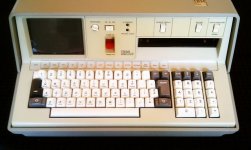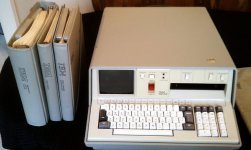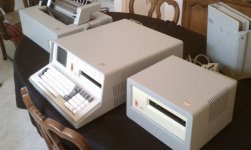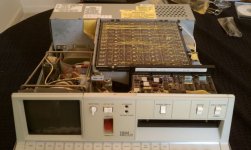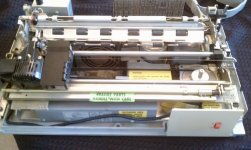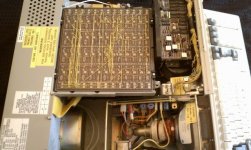Hello all,
I was recently able to acquire a complete IBM 5100 system including a 5103 printer, 5106 tape drive, documentation, and tape cartridges from one of the original owners of the company that purchased it in 1978. It was used for only a year or so before being put into storage, so everything is in beautiful condition. I have powered the computer on and it appears to be operational, but have hesitated to do much more until I familiarize myself with it's operation and evaluate it's condition. I am hoping to get the system fully operational, but there are a few issues I need to address and I have some questions about the best way to proceed. I would welcome advice from anyone familiar with the 5100 line of machines.
The two tape drives are the only means to load anything into the massive 16k of memory of the 5100, and the only means of storage, so I want to make sure that there is nothing I need to check or be concerned with on these before trying to use them. I know the rubber capstans can be bad on the old tape drives, but these appear solid. If anyone knows of anything else I should check on these I'd be interested to hear.
A related concern is the tape cartridges. These are now 35 years old, and their condition is unknown. I have a few IBM supplied cartridges as well as some that were used for data. I want to try to copy the original IBM tapes to fresh cartridges if possible before I do anything else with the machine. Anyone have any suggestions or tips on doing this? I think I may be missing at least one key tape (although I have some tapes that are not labelled and it may be one of those). If anyone has backups of any of the original IBM tape cartridges, or can make copies of these for me that I could purchase I would be very appreciative. When I have the system up and running I hope to be able to provide copies of my tapes, or others, to anyone who might need them. I also have some documentation that I have not seen online. I would be happy to scan anything I have if someone needs it.
One last thing concerns the 5103 printer. This is the only printer that will work with this machine, so I need to address two issues I have found. The tractor feed for this attaches to the printer by means of two clips on each end. On one end of mine one of the clips was broken at some point. I can probably repair it, but I would like to find a replacement part. I also need to locate some small parts for the ribbon drive (roller assemblies). These would have been cheap easy to replace in 1978, but not so now. Does anyone know someone who might have any of these parts, or maybe a 5103 parts unit?
I'm sure I will run into more issues as I go, but these are my priorities at the moment. I welcome any ideas or input anyone has.
slimbob
I was recently able to acquire a complete IBM 5100 system including a 5103 printer, 5106 tape drive, documentation, and tape cartridges from one of the original owners of the company that purchased it in 1978. It was used for only a year or so before being put into storage, so everything is in beautiful condition. I have powered the computer on and it appears to be operational, but have hesitated to do much more until I familiarize myself with it's operation and evaluate it's condition. I am hoping to get the system fully operational, but there are a few issues I need to address and I have some questions about the best way to proceed. I would welcome advice from anyone familiar with the 5100 line of machines.
The two tape drives are the only means to load anything into the massive 16k of memory of the 5100, and the only means of storage, so I want to make sure that there is nothing I need to check or be concerned with on these before trying to use them. I know the rubber capstans can be bad on the old tape drives, but these appear solid. If anyone knows of anything else I should check on these I'd be interested to hear.
A related concern is the tape cartridges. These are now 35 years old, and their condition is unknown. I have a few IBM supplied cartridges as well as some that were used for data. I want to try to copy the original IBM tapes to fresh cartridges if possible before I do anything else with the machine. Anyone have any suggestions or tips on doing this? I think I may be missing at least one key tape (although I have some tapes that are not labelled and it may be one of those). If anyone has backups of any of the original IBM tape cartridges, or can make copies of these for me that I could purchase I would be very appreciative. When I have the system up and running I hope to be able to provide copies of my tapes, or others, to anyone who might need them. I also have some documentation that I have not seen online. I would be happy to scan anything I have if someone needs it.
One last thing concerns the 5103 printer. This is the only printer that will work with this machine, so I need to address two issues I have found. The tractor feed for this attaches to the printer by means of two clips on each end. On one end of mine one of the clips was broken at some point. I can probably repair it, but I would like to find a replacement part. I also need to locate some small parts for the ribbon drive (roller assemblies). These would have been cheap easy to replace in 1978, but not so now. Does anyone know someone who might have any of these parts, or maybe a 5103 parts unit?
I'm sure I will run into more issues as I go, but these are my priorities at the moment. I welcome any ideas or input anyone has.
slimbob

